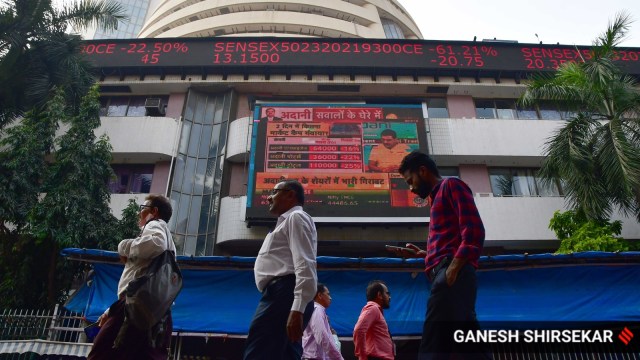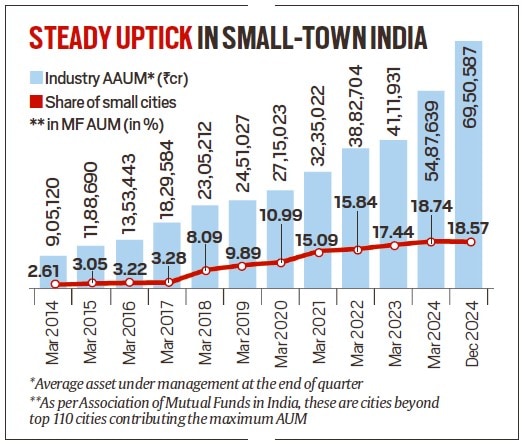THE SHARP and continuous stock market slide, with Nifty and Sensex dropping 15 per cent or so in the last five months, may not be extraordinary in terms of the quantum of decline, but is having an outsized impact on a large number of people, given how the investor community has burgeoned, spreading deep and wide into the country.

In just four weeks since the Budget was presented, said a big fund manager, the positive market sentiment — that the tax cut would kick start consumption and resuscitate flagging demand — has evaporated with the shock of a more than 5 per cent dip in the benchmark indices.
Story continues below this ad
What has remarkably changed over the last five years to decade is the way equity culture has struck roots across regions in India, going far beyond the metros, and Tier-I and Tier-II cities. Mutual funds have brought a new set of investors beyond the traditional middle class into the stock markets. It is during the BJP-led NDA rule that India witnessed this secular transition of participation of investors from smaller towns contributing to the assets under management of mutual funds.
In other words, equity is a mass product now. The total number of investors registered with the National Stock Exchange has jumped more than five times to almost 22 crore by February 2025. In terms of the extent of geography covered now, one in every five rupee invested in MFs comes from cities beyond the top 110 cities contributing to MF assets.
For a majority of those who took to investing in equities directly or through MFs after the pandemic, a sustained fall is something of an aberration, one that they have not faced ever before. With increase in income or wages remaining stagnant or low, the only significant increase in their net worth has been on account of the rise in net asset values of their MF schemes, and gains in stock prices.

This had been a big, and resilient, sentiment booster till recently. “It is for this reason that the stock market fall matters so much today,” said another independent fund manager, who also did not wish to be named.
Equity, a mass product now
Story continues below this ad
In March 2014, cities beyond the top 110 cities (as disclosed by industry body Association of Mutual Funds of India) accounted for assets under management of around Rs 23,624 crore, or 2.61 per cent of the overall industry average AUM of Rs 9,05,120 crore.
By March 2020, this rose to Rs 2.98 lakh crore, or nearly 11 per cent of the total industry average AUM of Rs 27.15 lakh crore, and by December 2024, to Rs 12.9 lakh crore, or nearly 18.6 per cent of the industry average AUM of Rs 6.59 lakh crore. In effect, nearly one in five rupee invested now comes from outside of the top 110 cities.
The number of demat accounts as of January 2025 stood at 18.8 crore, a near five-fold increase from just 4.1 crore in March 2020. If equity investment was more of an investment asset class for well-heeled, evolved investors earlier, over the last 10 years, it has become more of a mass product and the number of households having direct exposure to equity markets — through stocks or mutual funds — is much higher. The impact of a sustained fall, thereby, is far more spread out now, both in terms of income groups and geographical spread.
Among NSE registered investors, the biggest growth is in northern and western states, which have been traditional electoral strongholds for the ruling BJP and allies. While the biggest rise in absolute number of investors was seen in Maharashtra (which added 2.73 crore investors during this period), it was followed by Uttar Pradesh, which added 1.97 crore investors and Gujarat that added 1.28 crore registered investors.
Story continues below this ad
When it comes to highest percentage growth in number of registered investors (among top 20 states with at least 20 lakh registered investors) — Assam comes on top with a 1,114 per cent jump, followed by Bihar with a growth of 680 per cent in the number of registered investors. Next in line are Madhya Pradesh (568%), Chhattisgarh (529 per cent and Uttar Pradesh (497 per cent).
Uttar Pradesh and Bihar are among states that go to polls over the next 24 months.
Can the market fall dent the economy
“As far as mutual funds are concerned, it is not much of an issue as they are investing for the long term, however, those venturing through direct stock investment and into segments such as futures and options to make money in the short-term will feel the heat, as many of them have not witnessed a slump in their short investing lifecycle,” said the CEO of a large mutual fund.
There is also a feeling that if the markets continue to fall further, or remain weak for a few more months, it could impact the spending and consumption patterns.
Story continues below this ad
“If the pain in equity markets extends for a longer period, which is likely to be the case in the mid and small cap segment, then it may start hurting spending and consumption in the economy. That is because a decline in networth will weaken the sentiment and also lower their capacity to spend,” said a Mumbai-based economist, who did not wish to be named.
There is also the impact in terms of the market segments. The decline in mid and small caps could end up hurting the lower segment of investors more than the HNIs and the affluent class, as the former typically have a higher share of their portfolio exposed to the mid and small caps. In comparison, the affluent investors have more balanced exposure to the mid and small caps as those investors are more evolved in nature, and typically take longer term bets.


































